-

新人教版高中英语必修2Unit 3 The Internet-Reading and Thinking教案一
Paragraph 3. Jan decided to start an IT club to teach old people how to use computers and the Internet. Paragraph 4. Jan has started taking online classes to learn more about how to use the Internet to make society better. Paragraph 5. Jan’s life has been greatly improved by the Internet. Step 5: Critical thinking:(1)How do you arrange your time spent on study and the Internet? Is it reasonable? I usually surf the Internet using my mobile phone for only an hour after class, and it is reasonable for me.(2)What are your online activities? Are they safe? I chat with my friends, read news and play games. I never give away my private information so I think they are safe.Step 4: summary Much has been written about the wonders of the World Wide Web. There are countless articles (1)______(tell) us how the Internet has made our lives more convenient. But the Internet has done a lot (2)_____(much) for people than simply make life more convenient. People’s lives (3) _________________(change) by online communities and social networks so far. Take Jan for example, who developed a serious illness that made her (4)_____(stick) at home with only her computer to keep (5)___(she) company. She joined an online group (6)______ she could share problems, support and advice with others. She considered the ability to remove the distance between people as one of the greatest (7)_______(benefit). She was so inspired (8)____ she started an IT club in which many people have been helped. She has started to learn more about how to use the Internet to make society better. Her next goal is to start a charity website to raise money (9)___ children in poor countries. Jan’s life has been (10)______(great) improved by the Internet. Step 5 Homework:Review what we have learned and find out the key language points in the text.

新人教版高中英语必修2Unit 4 History and Traditions-Listening&Speaking&Talking教案一
This unit is about history and traditions. From the opening page, we can know that this unit will introduce the history and traditions around the world. As Marcus Garvey says “A people without the knowledge of their past history, origin and culture is like a tree without roots”, it is important for students to realize the importance and value of knowing the history and traditions and their further meanings. And this part ( listening and speaking ) is divided into two parts: Part A---share views on historic sites, Part B ---talk about a visit to a historic tourist destination. By talking with a foreigner, the speakers introduce the historic attractions and their cultures. Part A is that William, a British student, who was going to visit the Confucius Temple and a Chinese student, Xiao Kong, who was going to the Confucius Temple to meet with the members of the research group, went together and exchanged their views on the Confucius Temple, Confucius, Confucius' descendants and Confucius' educational thoughts. Part B is a conversation between Xiao Yan, a youth hostel receptionist and Paul, a backpacker about the feelings and experience after visiting the Chinese famous tourist attraction Pingyao.1. Guide students to understand the content of listening texts in terms of the whole and key details; 2. Cultivate students' ability to guess the meaning of words in listening; discuss with their peers how to talk about historic spots and great person.3. Instruct students to use functional sentences of showing one’s excitement, surprise and disappointment.1. Guide students to understand the content of listening texts in terms of the whole and key details; 2. Cultivate students' ability to discuss with their peers the related topics.3. Enable students to use the functional items of showing one’s excitement, surprise and disappointment.
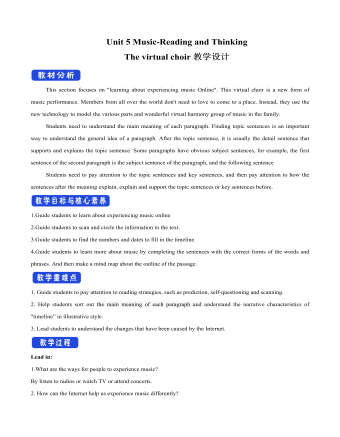
新人教版高中英语必修2Unit 5 Music-Reading and Thinking教案一
This section focuses on "learning about experiencing music Online". This virtual choir is a new form of music performance. Members from all over the world don't need to love to come to a place. Instead, they use the new technology to model the various parts and wonderful virtual harmony group of music in the family. Students need to understand the main meaning of each paragraph. Finding topic sentences is an important way to understand the general idea of a paragraph. After the topic sentence, it is usually the detail sentence that supports and explains the topic sentence. Some paragraphs have obvious subject sentences, for example, the first sentence of the second paragraph is the subject sentence of the paragraph, and the following sentenceStudents need to pay attention to the topic sentences and key sentences, and then pay attention to how the sentences after the meaning explain, explain and support the topic sentences or key sentences before.1.Guide students to learn about experiencing music online2.Guide students to scan and circle the information in the text.3.Guide students to find the numbers and dates to fill in the timeline.4.Guide students to learn more about music by completing the sentences with the correct forms of the words and phrases. And then make a mind map about the outline of the passage.1. Guide students to pay attention to reading strategies, such as prediction, self-questioning and scanning.2. Help students sort out the main meaning of each paragraph and understand the narrative characteristics of "timeline” in illustrative style.3. Lead students to understand the changes that have been caused by the Internet.

新人教版高中英语必修2Unit 5 Music-Reading For Writing教案一
(4)Now we have heard a number of outstanding speeches ... 我们已经聆听了许多精彩的发言……(5)Because we wanted the nations of the world, working together, to deal with ... 因为我们希望全世界各国团结起来去应对……(6)And if we do not act ... 如果我们不采取行动……(7)Now, I share the concerns that have been expressed ... 我也同意对于……表达的担心(8)Let us show the world that by working together we can ... 让我们告诉全世界,通过一起努力我们可以……(9)It is now time for us to ... 是时候我们……(10)And I have always wished that ... 我一直希望……(11)Thank you for letting me share this day with me.感谢你们和我共度这一天。实践演练:假如你是高中生李华,你校将举办一次以“音乐”为主题的演讲比赛,请你按照主题,写下你的演讲稿。注意:词数100左右。First of all, thank you for listening to my speech. My topic is: love music like love yourself.Music is like the air we need to maintain our normal lives around us. You can't imagine how terrible a world without music would be. Movies and TV shows have no music, only dry conversations and scenes; mobile phones only vibrations; streets only noisy crowds; cafes, western restaurants only depressed meals. What a terrible world it is!As a student, I hope we all can enjoy the fun brought by music in our spare time. Instead of just listening to music, we can even make our own music. Let's enjoy the fun of music!Thanks again for your attention!

人教部编版七年级下册太空一日教案
三、畅意表达,理解英雄1.畅意表达。师:通过学习课文,你们明白了杨利伟为什么被称为“航天英雄”吗?请同学们大胆表达自己的想法。(生自由交流回答)预设 杨利伟是中国人民解放军航天员大队的首飞航天员,圆满完成了中国的第一次载人航天飞行任务。在充满不可预料的各种危险和意外的情况下,杨利伟为了国家、民族的利益奋不顾身,他具有不怕牺牲、敢于牺牲的大无畏精神和拼搏勇气,所以被称为“航天英雄”。2.理解英雄。师:是否只有为国捐躯者才能成为英雄呢?请同学们四人一小组讨论一下,然后说说你们组的意见。(生小组内交流讨论后,推荐代表在全班交流,师指导明确)预设 不是的。凡是为了国家、民族的利益而不顾个人安危,并为此奉献出自己的智慧和力量的人,都应该给予英雄的荣誉。杨利伟在中国的第一次载人航天飞行中,遇到许多突发事件,危难考验不时出现,如果没有大无畏的精神,没有为国家、民族做贡献的意识,是不可能临危不惧、坚持到底的。
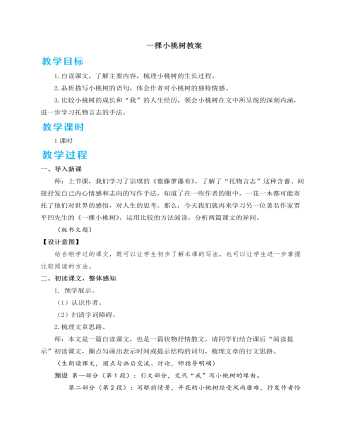
人教部编版七年级下册一棵小桃树教案
第三部分(第3—8段):写小桃树艰难曲折的生长过程。第四部分(第9—14段):回到眼前情景,生动地描写小桃树在风雨中的挣扎。3.理清小桃树的生长过程。师:作者写小桃树时,将眼前之景与回忆交叉叙写。请同学们按照时间顺序,理清小桃树的生长过程。预设 小桃树的生长过程:桃核被埋在院子角落里(“我”将它忘却)—萌芽(嫩绿)—长到二尺来高(样子极猥琐)—有院墙高了(被猪拱,讨人嫌,被遗忘,奶奶照顾)—开花(弱小,遭大雨,没有蜂蝶恋过,花零落,在雨中挣扎)—高高的一枝儿上保留着一个欲绽的花苞(在风雨中摇着愣是没掉下去,像风浪里航道上的指示灯)。师小结:小桃树的经历充满磨难:在几乎被“我”忘却的时候却破土而出;出生后瘦弱可怜,遭到大家的嘲笑,连奶奶也说它没出息;它被猪拱过,又险些被砍掉;它第一次开花就遭到风雨的摧残。但是,它一直顽强地生长,勇敢地与风雨搏斗,努力地绽放。本环节旨在运用圈点批注法理解作者对小桃树的情感。既能培养学生品析语言的能力,又能在把握小桃树意象的基础上准确体会作者的情感。
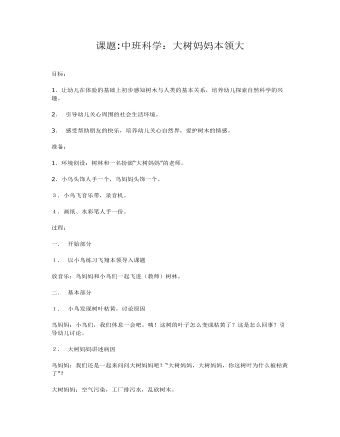
中班科学课件教案:大树妈妈本领大
2. 引导幼儿关心周围的社会生活环境。3. 感受帮助朋友的快乐,培养幼儿关心自然界,爱护树木的情感。准备:1.环境创设:树林和一名扮演“大树妈妈”的老师。2.小鸟头饰人手一个,鸟妈妈头饰一个。3.小鸟飞音乐带,录音机。4.画纸、水彩笔人手一份。
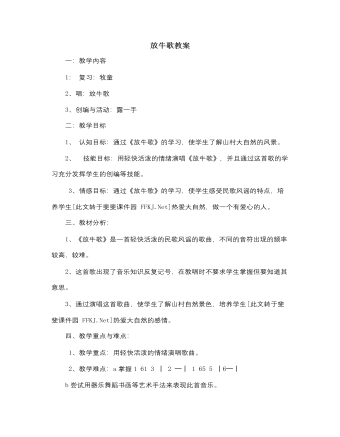
人音版小学音乐一年级下放牛歌教案
你能不能用你的本领把这山村美景表达出来呢? 老师请画画的小朋友在这花丛里,写诗的在小山坡上……….. 四、完美结课: 小朋友玩的高兴吗?好我们一起回家啦!(播放《郊游》)。 教学反思: 启发学生“你都想到了什么?”从而让学生展开丰富的想象,经过教师的简单小结使学生了解了牧童的生活和放牧时的心情,为学唱歌曲《放牛歌》做情感铺垫。 接下来的“体验理解”环节还是以激发学生兴趣为主,从猜小牧童的“宝贝”(笛子)模仿小牧童吹笛子的动作,到学吹笛子的有节奏的嘀嘀声XXXXXX,到有节奏的模仿小黄牛的叫声X-,我都是在让学生从间奏入手的,目的:一是引导学生会听音乐,能听出哪是间奏;二是让学生充分感受歌曲的旋律,熟悉歌曲;三是培养学生[此文转于斐斐课件园 FFKJ.Net]节奏感,知道笛声和小黄牛的叫声表示的节奏是什么,对两个声部的节奏训练进行一次渗透和尝试。
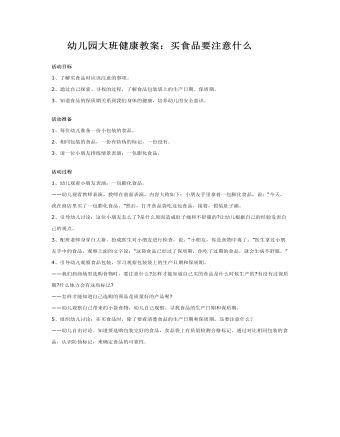
幼儿园大班健康教案:买食品要注意什么
活动准备 1、每位幼儿准备一份小包装的食品。 2、相同包装的食品,一份有防伪的标记,一份没有。 3、请一位小朋友排练情景表演:一包膨化食品。 活动过程 1、幼儿观看小朋友表演:一包膨化食品。 ——幼儿观看教师表演。教师在前面表演,内容大致如下:小朋友手里拿着一包膨化食品,说:“今天,我在商店里买了一包膨化食品。”然后,打开食品袋吃这包食品,接着,假装肚子痛。 2、引导幼儿讨论:这位小朋友怎么了?是什么原因造成肚子痛和不舒服的?让幼儿根据自己的经验发表自己的观点。 3、配班老师身穿白大褂,扮成医生对小朋友进行检查,说:“小朋友,你是食物中毒了。”医生拿过小朋友手中的食品,观察上面的文字说:“这袋食品已经过了保质期,你吃了过期的食品,就会生病不舒服。”
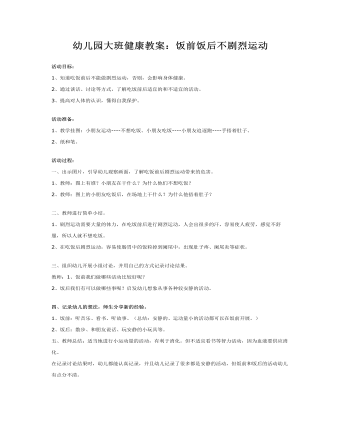
幼儿园大班健康教案:饭前饭后不剧烈运动
活动准备: 1、教学挂图:小朋友运动----不想吃饭。小朋友吃饭----小朋友追逐跑----手捂着肚子。 2、纸和笔。 活动过程: 一、出示图片,引导幼儿观察画面,了解吃饭前后剧烈运动带来的危害。 1、教师:图上有谁?小朋友在干什么?为什么他们不想吃饭? 2、教师:图上的小朋友吃饭后,在场地上干什么?为什么他捂着肚子? 二、教师进行简单小结。 1、剧烈运动需要大量的体力,在吃饭前后进行剧烈运动,人会出很多的汗,容易使人疲劳,感觉不舒服,所以人就不想吃饭。 2、在吃饭后剧烈运动,容易使肠胃中的饭粒掉到阑尾中,出现肚子疼、阑尾炎等症状。

幼儿园大班健康教案:绿色食品和垃圾食品
活动准备 1、一些和饮食卫生有关的图片若干。 2、幼儿用书人手一册,红色彩笔人手一支。活动过程 1、幼儿进行谈话活动: 1)教师:你喜欢吃什么食品?为什么? 2)教师将幼儿说的各类食品一一贴在黑板上或快速地画在黑板上,并进行分类。 2、通过观察幼儿用书,了解注意饮食卫生的重要。 1)看图说说:图上的小朋友在做什么?想一想这样做对吗?为什么? 2)观察画面,说说:这些小朋友怎么啦?他们为什么会生病? 例如:观察拉肚子的小朋友,说说:为什么他会拉肚子?(吃蔬果不清洗,也没有洗手。)……观察一名肥胖儿童:他为什么会这么胖?(他吃的东西太多了、甜食吃多了、油腻的食物吃多了……)
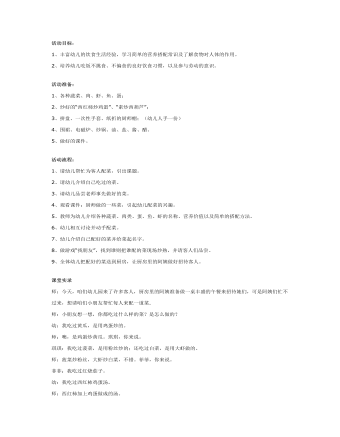
幼儿园大班健康教案:我是厨房小帮手
活动准备: 1、各种蔬菜、肉、虾、鱼、蛋; 2、炒好的“西红柿炒鸡蛋”、“素炒西葫芦”; 3、拼盘、一次性手套、纸折的厨师帽;(幼儿人手一份) 4、围裙、电磁炉、炒锅、油、盐、酱、醋。 5、做好的课件。 活动流程: 1、请幼儿帮忙为客人配菜,引出课题。 2、请幼儿介绍自己吃过的菜。 3、请幼儿品尝老师事先做好的菜。 4、观看课件:厨师做的一些菜,引起幼儿配菜的兴趣。 5、教师为幼儿介绍各种蔬菜、肉类、蛋、鱼、虾的名称、营养价值以及简单的搭配方法。 6、幼儿相互讨论并动手配菜。 7、幼儿介绍自己配好的菜并给菜起名字。 8、做游戏“找朋友”,找到谁则把谁配的菜现场炒熟,并请客人们品尝。 9、全体幼儿把配好的菜送到厨房,让厨房里的阿姨做好招待客人。
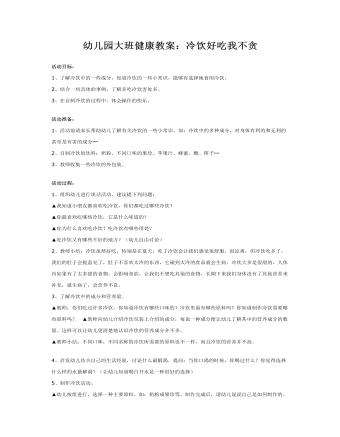
幼儿园大班健康教案:冷饮好吃我不贪
活动准备:1、活动前请家长帮助幼儿了解有关冷饮的一些小常识。如:冷饮中的多种成分,对身体有利的和无利的甚至是有害的成分┉2、自制冷饮的饮料:奶粉、不同口味的果珍、苹果汁、蜂蜜、糖、筷子┉3、教师收集一些冷饮的外包装。 活动过程: 1、组织幼儿进行谈话活动。建议提下列问题: ▲我知道小朋友都喜欢吃冷饮,你们都吃过哪些冷饮? ▲你最喜欢吃哪些冷饮,它是什么味道的? ▲你为什么喜欢吃冷饮?吃冷饮有哪些用处? ▲吃冷饮又有哪些不好的地方?(幼儿自由讨论)
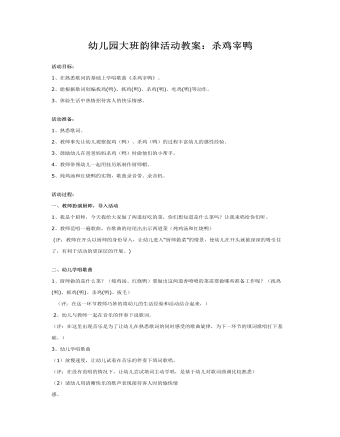
幼儿园大班韵律活动教案:杀鸡宰鸭
2、能根据歌词创编找鸡(鸭)、抓鸡(鸭)、杀鸡(鸭)、吃鸡(鸭)等动作。 3、体验生活中热情招待客人的快乐情感。 活动准备: 1、熟悉歌词。 2、教师事先让幼儿观察捉鸡(鸭)、杀鸡(鸭)的过程丰富幼儿的感性经验。 3、鼓励幼儿在爸爸妈妈杀鸡(鸭)时做他们的小帮手。 4、教师带领幼儿一起用挂历纸制作厨师帽。 5、炖鸡汤和红烧鸭的实物,歌曲录音带、录音机。 活动过程: 一、教师扮演厨师,导入活动 1、我是个厨师,今天我给大家做了两道好吃的菜,你们想知道是什么菜吗?让我来唱给你们听。 2、教师范唱一遍歌曲,在歌曲的结尾出出示两道菜(炖鸡汤和红烧鸭) (评:教师在开头以厨师的身份导入,让幼儿进入“厨师做菜”的情景,使幼儿在开头就被深深的吸引住了,有利于活动的更深层的开展。)
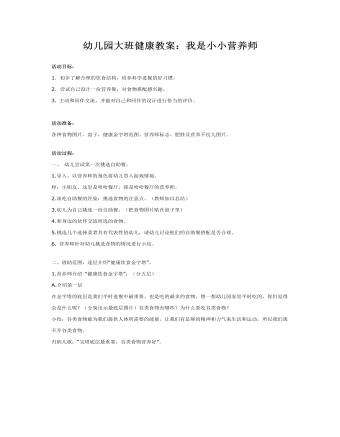
幼儿园大班健康教案:我是小小营养师
活动准备: 各种食物图片、盘子,健康金字塔范图、营养师标志、肥胖及营养不良儿图片。 活动过程: 一、幼儿尝试第一次挑选自助餐。 1.导入。以营养师的角色将幼儿带入游戏情境。 师:小朋友,这里是哈哈餐厅,我是哈哈餐厅的营养师。 2.谈吃自助餐的经验:挑选食物的注意点。(教师加以总结) 3.幼儿为自己挑选一份自助餐。(把食物图片贴在盘子里) 4.和身边的伙伴交流所选的食物。 5.挑选几个选择菜肴具有代表性的幼儿,请幼儿讨论他们的自助餐搭配是否合理。 6. 营养师针对幼儿挑选食物的情况进行小结。
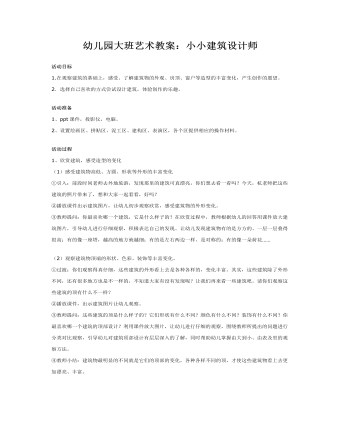
幼儿园大班艺术教案:小小建筑设计师
活动准备 1、ppt课件,投影仪,电脑。 2、设置绘画区、拼贴区、泥工区、建构区、表演区,各个区提供相应的操作材料。 活动过程 1、欣赏建筑,感受造型的变化 (1)感受建筑物高低、方圆、形状等外形的丰富变化 ①引入:前段时间老师去外地旅游,发现那里的建筑可真漂亮,你们想去看一看吗?今天,杭老师把这些建筑的照片带来了,想和大家一起看看,好吗? ②播放课件出示建筑图片,让幼儿初步观察欣赏,感受建筑物的外形变化。 ③教师提问:你最喜欢哪一个建筑,它是什么样子的?在欣赏过程中,教师根据幼儿的回答用课件放大建筑图片,引导幼儿进行仔细观察,积极表达自己的发现。让幼儿发现建筑物有的是方方的、一层一层叠得很高;有的像一座塔,越高的地方就越细;有的是左右两边一样、是对称的;有的像一朵荷花……
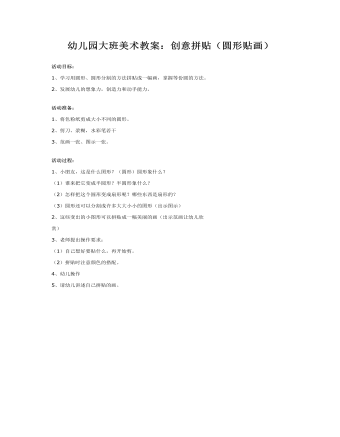
幼儿园大班美术教案:创意拼贴(圆形贴画)
活动准备:1、将色粉纸剪成大小不同的圆形。2、剪刀、浆糊,水彩笔若干3、范画一张、图示一张。活动过程:1、小朋友,这是什么图形?(圆形)圆形象什么?(1)谁来把它变成半圆形?半圆形象什么?(2)怎样把这个圆形变成扇形呢?哪些东西是扇形的?(3)圆形还可以分割成许多大大小小的图形(出示图示)
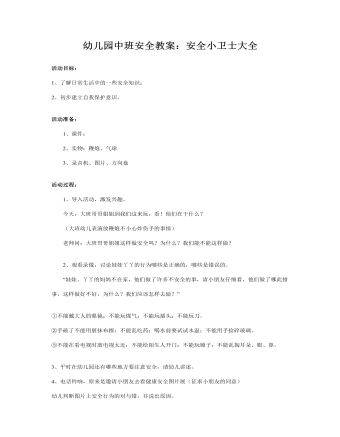
幼儿园中班安全教案:安全小卫士大全
活动准备:1、课件;2、实物:鞭炮、气球3、录音机、图片、方向盘活动过程:1、导入活动,激发兴趣。 今天,大班哥哥姐姐到我们这来玩,看!他们在干什么? (大班幼儿表演放鞭炮不小心炸伤手的事情) 老师问:大班哥哥姐姐这样做安全吗?为什么?我们能不能这样做?
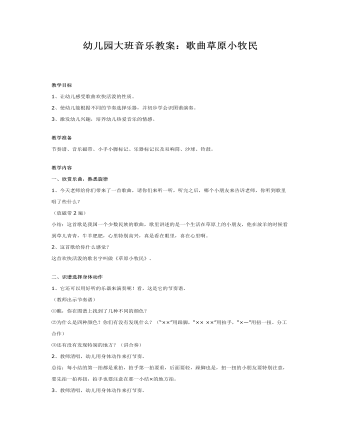
幼儿园大班音乐教案:歌曲草原小牧民
教学准备 节奏谱、音乐磁带、小手小脚标记、乐器标记以及双响筒、沙球、铃鼓。教学内容一、欣赏乐曲,熟悉旋律 1、今天老师给你们带来了一首歌曲,请你们来听一听,听完之后,哪个小朋友来告诉老师,你听到歌里唱了些什么? (放磁带2遍) 小结:这首歌是我国一个少数民族的歌曲,歌里讲述的是一个生活在草原上的小朋友,他在放羊的时候看到草儿青青,牛羊肥肥,心里特别高兴,真是看在眼里,喜在心里啊。 2、这首歌给你什么感觉? 这首欢快活泼的歌名字叫做《草原小牧民》。二、识谱选择身体动作 1、它还可以用好听的乐器来演奏呢!看,这是它的节奏谱。 (教师出示节奏谱) ⑴瞧,你在图谱上找到了几种不同的颜色? ⑵为什么是四种颜色?你们有没有发现什么?(“××”用跺脚,“×× ××”用拍手,“×—”用扭一扭。分工合作)
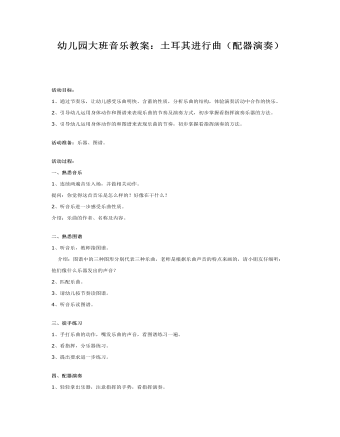
幼儿园大班音乐教案:土耳其进行曲
2、引导幼儿运用身体动作和图谱来表现乐曲的节奏及演奏方式,初步掌握看指挥演奏乐器的方法。 3、引导幼儿运用身体动作的和图谱来表现乐曲的节奏,初步掌握看指挥演奏的方法。 活动准备:乐器、图谱。 活动过程: 一、熟悉音乐 1、连续两遍音乐入场,并做相关动作。 提问:你觉得这首音乐是怎么样的?好像在干什么? 2、听音乐进一步感受乐曲性质。 介绍:乐曲的作者、名称及内容。



